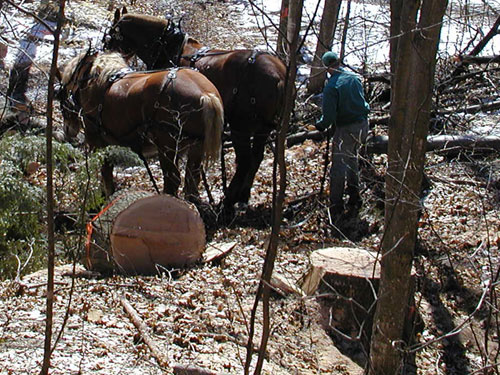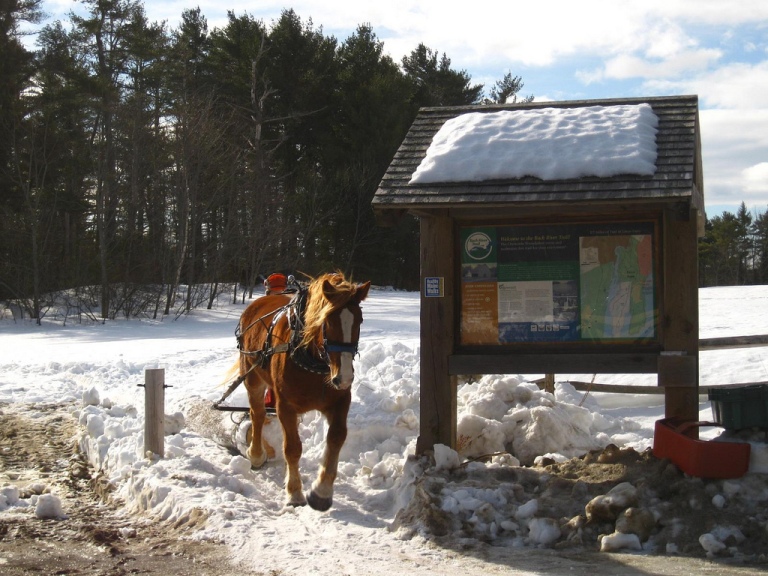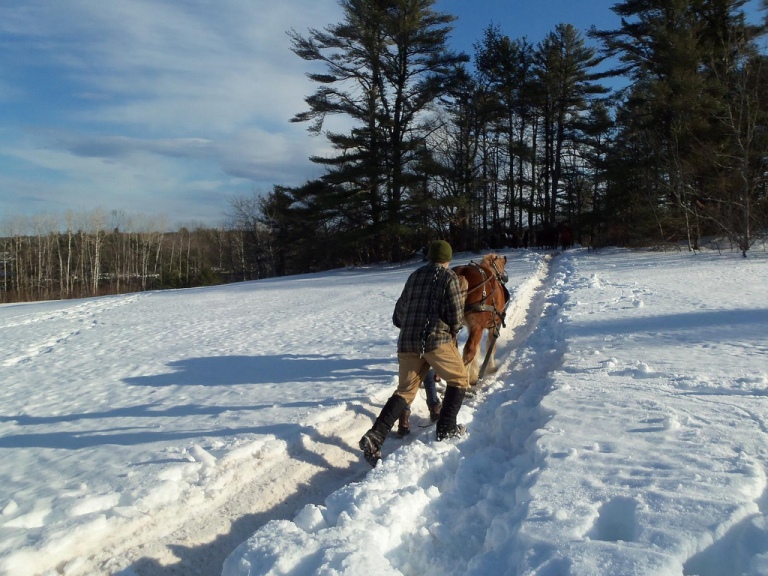Bring Some Horsepower to Your Logging
 Ask John Plowden about the advantages of animals over internal combustion engines for hauling wood out of forests, and he responds in emotional terms. “I love the smell of a horse rather than the smell of a tractor,” says Plowden, a logger who works with a team of Belgian draft horses in Stow, Maine. “Horses see things you don’t see. And when you have a big log and ask your animals to give you everything they have and they do and pull the log out, it’s gratifying." But for Tree Farmer Janet Benoit, of Careywood, Idaho, the reasons to hire a horse logger were more practical. She couldn’t find a large company to log her small woodland.
Ask John Plowden about the advantages of animals over internal combustion engines for hauling wood out of forests, and he responds in emotional terms. “I love the smell of a horse rather than the smell of a tractor,” says Plowden, a logger who works with a team of Belgian draft horses in Stow, Maine. “Horses see things you don’t see. And when you have a big log and ask your animals to give you everything they have and they do and pull the log out, it’s gratifying." But for Tree Farmer Janet Benoit, of Careywood, Idaho, the reasons to hire a horse logger were more practical. She couldn’t find a large company to log her small woodland.
How is horse logging different ?
Instead of seeing bulldozers and other heavy equipment on your Tree Farm, you’ll watch a single logger and two or three horses disappear into your forest. The horse logger will cut your trees one by one, hitch them to the horses and move them to a truck that carries loads to the mill.
Landowners who choose horse logging often do so to minimize the impact to their forests. “With horses, you still have a skid trail, but it’s the width of the horse’s gait and the log he’s pulling,” says Lynn Miner, a Tree Farmer who owns a 100-acre forest near Chewelah, Washington. And horses’ hooves compact the soil much less than do large tires. Six weeks after Miner’s horse logging took place, he could not see a trace of the operation.
Benoit’s experience was similar when a horse logger thinned her land. “Except for the fresh stumps …you couldn’t even really tell that he’d been there,” she says. “That’s the difference to me, that they can take out a few trees and not leave many traces.”
What forest management goals can horse logging achieve ?
 Landowners choose horse logging to meet a variety of goals.• Log small plots. Benoit originally planned to log her 40 acres with conventional equipment. But with the costs of bringing in machinery, it wasn’t economical. “When you have a small amount like I do, [conventional loggers] want more money because of the setup fees.”
Landowners choose horse logging to meet a variety of goals.• Log small plots. Benoit originally planned to log her 40 acres with conventional equipment. But with the costs of bringing in machinery, it wasn’t economical. “When you have a small amount like I do, [conventional loggers] want more money because of the setup fees.”
Instead, Benoit hired a logger who lived 35 miles away and brought his horses to her site. The logger worked with a trucker who drove her eight loads of logs to a nearby mill. The economics worked in her favor. “The horse logger did my logging for less per thousand than the guy with the equipment wanted,” she says.
• Skirt steep terrain. Topography affected Benoit’s situation, too. “I have some rather steep ground on my property, and nobody withequipment wanted to go up it,” Benoit says. “The horses could negotiate this.”
• Renew exhausted forests. Miner sought to restore a forest abused by years of high grading: For 100 years, the previous owners had plucked out the nicest trees. “From a forest-health perspective, it was in pretty rough shape.”
The gentler approach of horses allowed him to log while the forest recovered. Miner, who moved to his Washington property after years of city living, now is surrounded by a forest of “big, fat, juicy trees,” including ponderosa pines and Douglas fir. “It looks like a park.”
• Help flora and fauna. John Jahoda manages a forest near Pittsburg, New Hampshire, with a goal to promote wildlife. When he decided to clear two small areas to create better habitat for animals that like the forest edge, he sought a low-impact approach. “Horse logging was much less damaging to the forest.”
The wildlife approved. “Deer, moose, bear—we have those in large numbers,” along with wild turkey in one of the cleared areas, says Jahoda.
• Build trails. Plowden employs his horses to create trails for local landowners. “We have a  lot of folks who don’t live full-time on the land. They come for cross-country skiing or hiking and want to see variety.”
lot of folks who don’t live full-time on the land. They come for cross-country skiing or hiking and want to see variety.”
Sometimes Plowden and his horses clear old paths left by mechanical skidders, but a skidder can cover wet terrain that a horse-or a person—can’t cross. Often, Plowden and the landowner work with a forester to chart where a trail will go, and they build it to accommodate the horses’ abilities.
• Build structures. Plowden and his horses are helping to turn trees into outbuildings on a small plot that hosts sheep, chickens and a maple sugaring operation. Horse logger Jason Rutledge, of the Healing Harvest Forest Foundation in Copper Hill, Virginia, will clear a house site for customers and construct a log cabin from surrounding woods.
What are other benefits of horse logging?
Equine power is quieter than machinery, and it’s reliable. “I’ve never had a horse break down,” says Taylor Johnson, of Mule Skinner Horse Logging & Go Green Forest Products in Springbrook, Wisconsin.“ They always start when it’s cold.” Horses also don’t squash a potential investment, as large machinery can when it compacts the soil around root systems.
It’s also eco-friendly. “Horses operate on solar energy—pasture, hay and grain,” says Rutledge. No fossil fuels are needed.
What are the limitations?
Still, there are downsides. “It’s very slow,” says Miner. “You have a single man with a single horse pulling logs out of the forest, versus a machine that can pull 20 logs out of the forest at the same time. It just isn’t as efficient.” Extracting Miner’s lumber by horse—50,000 board feet, about 10 truckloads—took three months.
Because of the labor needed, it can be expensive. “The major impediment to horse logging is that the horse logger has to be quite selective in what he cuts so that he can make money,” says Jahoda. The price of pulp and logs must outweigh the logger’s costs. “He has to make money, and we have to make money,” Jahoda adds.
Access can be a challenge as well. Horse loggers need a road where a truck can come to receive and take the logs to the mill—ideally, downhill and away from wetlands. Parts of Jahoda’s woods do not have those roads or the lots are too far in to make hauling small loads feasible. Jahoda paid to install a landing on a rough road, where a truck could pick up the logs.
What is the economic potential?
 Horse logging can help a landowner manage the forest well, grow highquality trees and make more money over the long term, says Rutledge.“ Your forest is essentially a stock portfolio, and each tree is a stock,”says Rutledge. “I want landowners to be the ultimate inside traders, to know which of their trees are the most valuable and grow faster. Those are the ones we want to nurture.”
Horse logging can help a landowner manage the forest well, grow highquality trees and make more money over the long term, says Rutledge.“ Your forest is essentially a stock portfolio, and each tree is a stock,”says Rutledge. “I want landowners to be the ultimate inside traders, to know which of their trees are the most valuable and grow faster. Those are the ones we want to nurture.”
Several years of extra growth can be especially profitable. “I leave a lot of wood standing that they’d need to cut to get a machine through,” says Johnson. That wood, which would have been sold for $125 a cord, can be left to grow for another 10 to 15 years and then may be worth $500, he adds. “Where else can you put money in the bank and make that kind of money?”
Horse logging is especially economical for landowners who have unusual trees, such as birds-eye maple or an exceptional stand of walnut, says Johnson. Horse loggers can take out four or five logs and not have a $2,000 moving cost, he says. If a builder needs a special kind of log, a horse team can extract it easily, and the landowner can profit.
Rutledge’s organization has set up a network, Draftwood Forest Products, to enable forest owners to turn high-quality trees into countertops, doors, stair treads, cabinets and the like. For the most profit, “go from a tree to a finished product, if possible,” advises Johnson. And keep it local. “That’s what’s going to pay landowners in the future.”










Do you have the names and phone numbers of individuals who horse log in North Idaho?